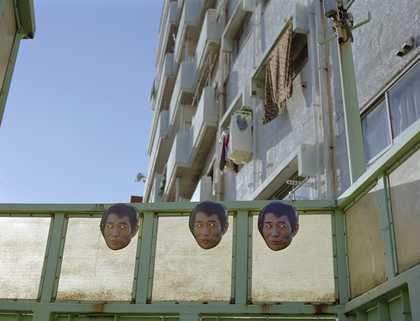This symposium will bring together experts and collaborators to reflect on the diverse media blend created by the Japanese poet, photographer and film-maker, whose stated profession was always ‘Terayama Shūji’.
Shūji Terayama was a child of postwar devastation, occupation and subsequent economic expansion markedly different to Japan after the ‘economic bubble’. Terayama’s works range in media from radio drama, experimental television, underground (Angura) theatre and countercultural critique to Japanese New Wave and expanded cinema. His art and its radical embrace of the carnivalesque continue to entrance and provoke audiences internationally.
Contributors include Nobuko Anan, Shigeru Matsui, Henriku Morisaki, Steven C. Ridgely, Julian Ross, Hiroyuki Sasame and Carol Fisher Sorgenfrei.
Organised by Thomas Dylan Eaton.
Morning
10.00–11.00: Introduces Terayama and his relationship to performance and theatre.
11.00–12.00: Addresses Kishida Rio (1946–2003), the ‘Female version of Terayama’.
Break
12.15: Screening of Americans, who are you? (America-jin Anata-wa…)
Shūji Terayama & Hagimoto Haruhiko, 1967 Japan, 16mm (screened on DVD), 40 min
13.00: Lunch
Afternoon
14.00–14.30: Shigeru Matsui discusses Terayama’s relationship to television and how he developed ideas in this medium that he would simultaneously use in performance.
14.30–15.30: Steve Ridgely discusses Terayama’s transmedia work. He will cover examples including Throw Away Your Books, Let’s Hit the Streets (1971), an experimental novel re-made into an experimental play and then into an experimental feature film.
Break
15.45–16.15: Julian Ross relates Terayama’s work to expanded cinema in Japan and Europe.
16.15–17.00: Plenary with all participants
Nobuko Anan
Her main research interests are modern and contemporary Japanese theatre/performance and visual arts, and the way that they intersect with nationhood and gender/sexuality in transnational contexts. Her most recent articles, ‘Two Dimensional Imagination in Contemporary Japanese Women's Performance’ appeared in TDR (The Drama Review) in November 2011, and ‘Identity Politics in Women's Performance in Japan’ appeared in Theatre Research International in February 2012. She is currently working on her first monograph on the intersection of girls' culture and performance in Japan.
Thomas Dylan Eaton
is a writer, curator and filmmaker. He has written for publications including Artforum, Afterall and Parkett. He studied in the Film Classat the Hochschule für Bildende Künste, Städelschule Frankfurt. He first heard of Shūji Terayama when Kenneth Anger posted a VHS tape of Emperor Tomato Ketchup to London’s Imperial War Museum.
Shigeru Matsui
is a poet and Research Lecturer at Graduate School of Film and New Media, Tokyo National University of the Arts. He researches 1950s-60s art and television with a special focus on how television reorganised visual culture. http://www008.upp.so-net.ne.jp/methodpoem
Henrikku Morisaki
A faithful collaborator of Shūji Terayama, Henrikku Morisaki is a behind-the-stage artist profoundly involved in a number of Terayama's theater and cinema projects. Having worked as an assistant director, production designer and sound supervisor, he has also acted in experimental performances that blur the borderline between cinema and real life.
Steven C. Ridgely
is assistant professor of Japanese at the University of Wisconsin-Madison where he teaches courses on modern Japanese literature, popular culture, and cinema. He is author of Japanese Counterculture: The Antiestablishment Art of Terayama Shūji (University of Minnesota Press, 2010) and ‘Tanizaki and the Literary Uses of Cinema’ (forthcoming from The Journal of Japanese and Korean Cinema).
Julian Ross
is a PhD candidate at the Centre for World Cinemas, University of Leeds, researching Japanese independent cinema of the 1960s and its interactions with other arts. He is a freelance film programmer, for which his recent projects include Takahiko Iimura’s UK Tour (Oct 2011) and Motoharu Jonouchi’s touring programme (Nov 2010 – Jan 2011). He is a commissioning editor for Vertigo magazine (re-launching online) and a contributor to the online blog Director’s Notes and Intellect’s Directory of World Cinema: Japan (2010–). He works for Close-Up Film Centre as a library assistant.
Hiroyuki Sasame
As a collector and preserver of the posters of Tenjō Sajiki, without which no discussion of the Terayama and the Japanese Underground would be complete, Hiroyuki Sasame, has undertaken a project to collect, preserve and exhibit the posters by legendary artists such as Tadanori Yokoo, Kiyoshi Awazu and Akira Uno.
Professor Carol Fisher Sorgenfrei
is a specialist in Japanese theatre and intercultural performance, as well as a playwright and director. Her book Unspeakable Acts: The Avant-Garde Theatre of TerayamaShuji and Postwar Japan (University of Hawaii, 2005) analyses the complex work of playwright/director/filmmaker Terayama in cultural/historical context, and includes translations of his plays and theory.
Curated by Thomas Dylan Eaton in association with Tate Modern.
With generous support from Daiwa Anglo-Japanese Foundation, Japan Foundation, Sasakawa Foundation, Toshiba Foundation, and All Nippon Airways.
Tate Film is supported by Maja Hoffmann / LUMA Foundation.

